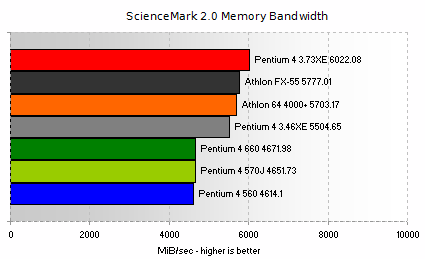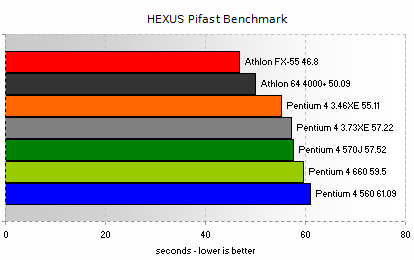Memory Tests
ScienceMark 2.0 - Memory Bandwidth

Prescott-2M, like Prescott-1M, can extract more buffered memory bandwidth from the memory controller on Intel chipsets (in this case, i925XE) than Gallatin-2M (which in turn shares the same main pipeline as Northwood). So while there's no real jump for the 660 versus the 550, the Prescott-2M-based XE has a result 500MB/sec higher than the older Gallatin-2M-based XE, at the same bus clock. Remember, the 266MHz-bus XEs run their memory at DDR710 on the ASUS mainboard.
The Athlon FX-based processors on test (remember, the FX-55 is emulating 4000+ for these tests) have always had masses of memory bandwidth available to them, running nearly 90% efficient in terms of peak theoretical bandwidth.
ScienceMark 2.0 - Memory Latency

Conversely, while it can extract more buffered memory bandwidth, the Prescott-based processors on test (both 1M and 2M) take longer to access main memory than Gallatin-2M/Northwood. Access latency scales with bus clock as expected, for the Pentium 4s. Finally, no Pentium 4 processor can hope to match the access latency of Athlon FX or 64, with their on-CPU memory controllers.
Pifast
Pifast shows off the effects of the memory subsystem and its performance.
Pifast's working set sits somewhere between the 1MiB and 2MiB cache levels we're testing and it's tracking access latency mostly. Raw FPU power obviously helps, the Athlon FX and 64 way ahead with the Gallatin-2M XE besting all the other Pentium 4s due to a shorter main pipeline.









